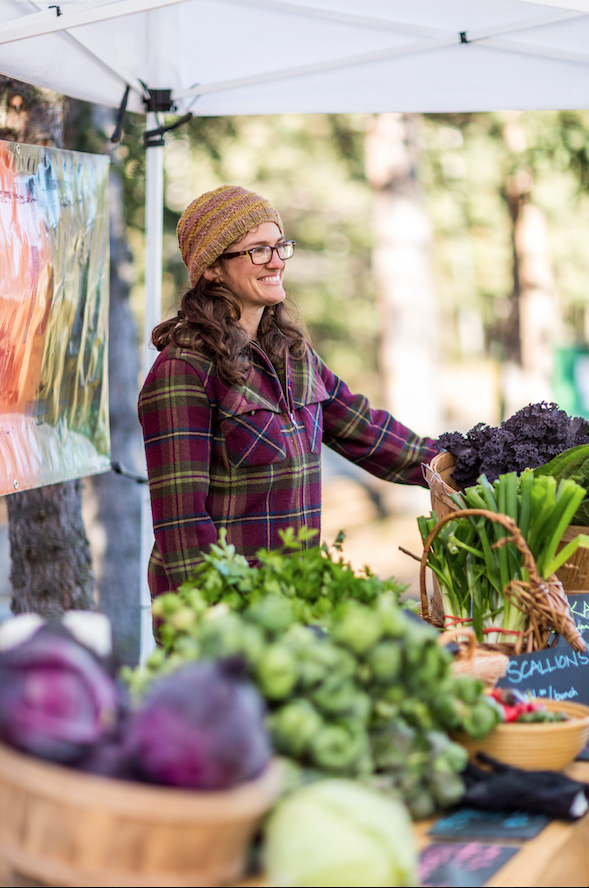 A cornucopia of riotously colorful fresh produce lays in wait in the Spring Creek Farms stand at APU’s farmers market each week during the summer. Boxes of jewel-toned zucchinis, rich-colored beets, and a myriad of multi-colored, fragrant herbs – all recently plucked – ready to go to good homes.
A cornucopia of riotously colorful fresh produce lays in wait in the Spring Creek Farms stand at APU’s farmers market each week during the summer. Boxes of jewel-toned zucchinis, rich-colored beets, and a myriad of multi-colored, fragrant herbs – all recently plucked – ready to go to good homes.
Some of them, though, are already claimed and have been since long before the fields shed their blankets of snow, the ground thawed, and the seeds from which they were spawned were even purchased. Those veggies are part of the CSA program.
Understanding CSA
CSA, the acronym for Community Supported Agriculture, is a model for farmers to sell directly to consumers. Customers buy a share of the farm at the beginning of the season in exchange for a weekly box of assorted produce.
Originating on two small scale farms on the east coast in 1986, the goal of CSA’s was to remove some of the financial risk from the farmer and spread it through the community who believe the farm served an important function in their lives. Pre-selling shares of produce allows the farmer to plan more precisely what they can grow and sell.
“It’s a great model for beginning farmers because it allows the farmer to start small and prevents them from losing their farm in a bad year,” farm manager Megan Talley said. “It is a social contract between the farmer and the consumer that allows for consumers to have more involvement in the food they choose to eat.”
The items in the share vary from week to week. In the spring CSA bags are laden with greens like sorrel, lettuce, arugula and roots such as sweet turnips, radishes, kohlrabi and scallions. As the season progresses, the pick-ups become more colorful and varied – carrots, beets, broccoli, cauliflower, kale, peas, napa cabbage, bok choi, storage cabbage, zucchini and herbs fill the bags. And into the fall they add in potatoes, Brussel sprouts, rutabaga, celery, and parsnips. Each pick-up is usually around two bags worth of food (at least $30 worth of produce).
The haul isn’t a surprise to CSA members, though. After farmers Talley and Joshua Faller (both students in the MAP program at APU) walk through the field each Monday, assessing what’s ready, what can wait and ultimately what will create a well-rounded CSA for the week, Talley will send out an email with the expected harvest list. With that, she’ll send recipe ideas and information on preservation if they have a particular abundance of something.
Growing, in more ways than one
Spring Creek Farm’s CSA launched in 2007. Enrollment has fluctuated as farmers have come and gone, though Talley said it’s been growing consistently in recent years. In 2016, the farm supplied 35 families with fresh produce, which also helped the farm grow enough to supply more produce to APU’s dining hall and donate a portion of produce to food insecure families. The goal for the 2017 season is to sell 65 full shares.
As the number of families served has increased it has helped birth a new training program for newbie growers. There have also been numerous infrastructure improvements to the farm, that have put them in position to grow more food. In 2014 they purchased a tractor and put up a 6-acre moose proof fence. In 2016 they built a terraced raised bed system in the greenhouse which will help extend the growing season. This summer they plan on building a wash station and cooler unit. All those efforts allow the farm to grow and sell more produce to model financial sustainability.
“My goal for the Spring Creek Farm CSA is to bring fresh produce to the APU and ANTHC community while training new growers in this model and developing a community that supports local agriculture education,” Talley said.
Food that has connection
“What’s great about the CSA model is that it supports beginning farmer education, farm to University efforts, and the work we are doing to build a more resilient local food system,” Talley said. “We view the CSA and the market as a place to build community around food.”
That community, Talley said, is her favorite part of working on the farm and in the farmers market.
“When people come to pick up their CSA, they’re excited,” Talley said. “They’re excited to talk about food, to hear more about it and have a connection with the person who grew their food. I love it. I could nerd out on it all day. It’s fun to be a part of a community of food enthusiasts.”
Talley said there are numerous ways for the APU community to get involved, beyond purchasing a share or shopping at the weekly farmer’s market. Right now the farm is accepting applications for workshare members who will help with weekly harvest in exchange for a share of the produce. There are also regular volunteer times on Saturday afternoons starting in July.
“It’s fun,” Talley said. “You learn so much about healthy eating and local agriculture and get to join a community of people who are enthusiasts about their food.”
Sign-up information for the CSA can be found here. Produce can also be purchased at the APU Farmers Market starting June 14th and running until mid-October, 11 AM to 6 PM.
